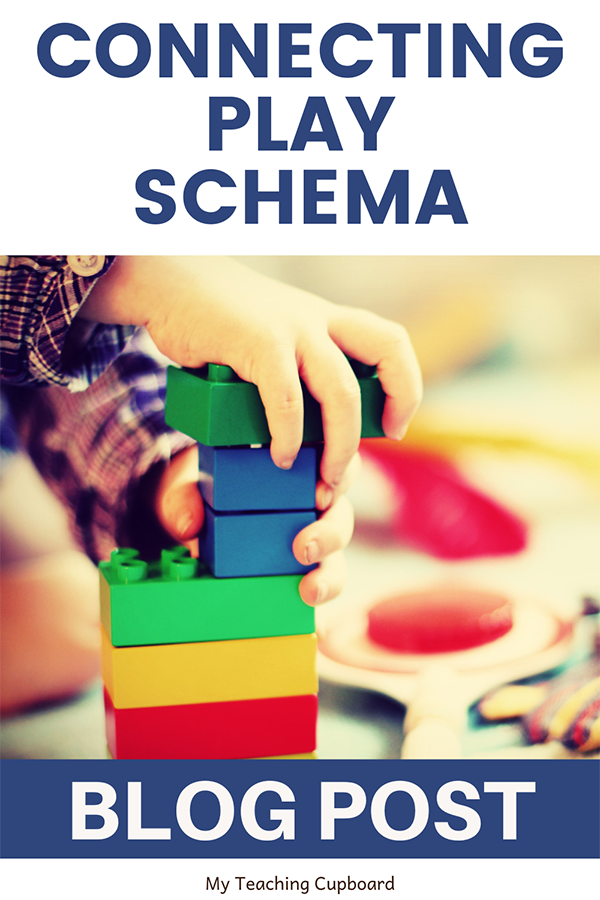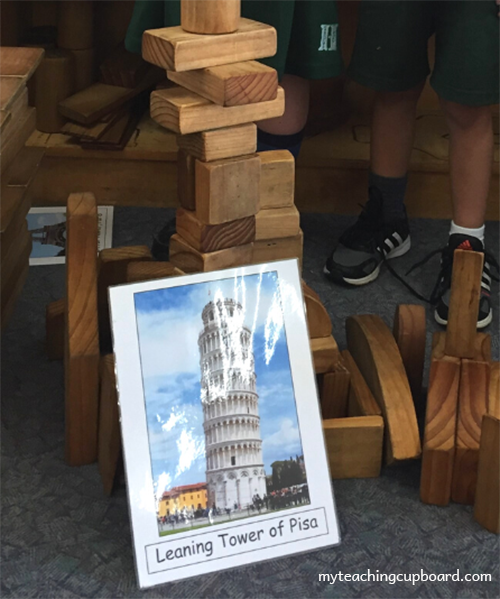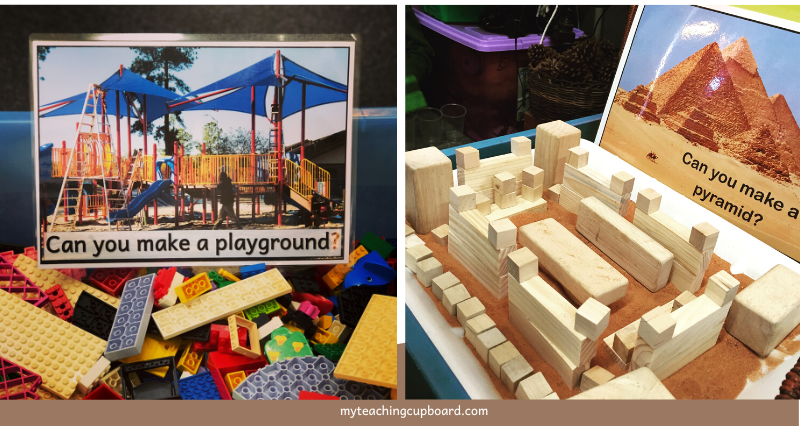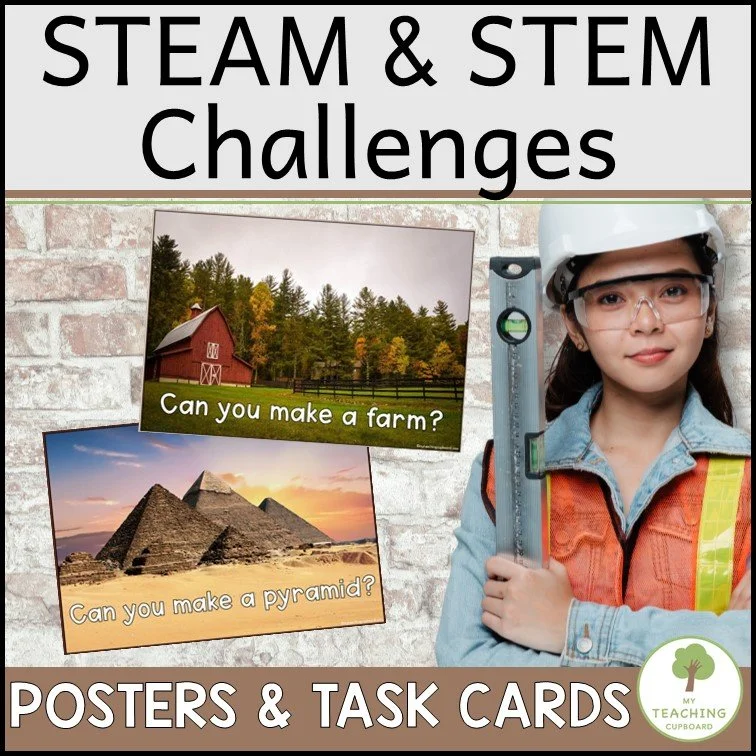The Connecting Schema
The connecting schema is all about how things connect and separate. If you have children in your classroom tying things together, fascinated with tape or building and knocking over towers of blocks, you might have children developing their connection schema.
This blog post will explain exactly what this play schema is and has a heap of playful hands-on activities you can easily use to support children in developing their connection schema.
What Is a Play Schema?
Schemas are repeated patterns of behaviour that children use to explore and learn about their world. Children are constantly trying to make sense of their world and they do this by using their play schemas in hands-on play-based learning experiences.
Children’s play schemas will change and develop over time. They become more and more sophisticated each time children face play-based learning experiences. Through repeated schematic play, children can use their existing knowledge to build new understandings and develop their schemas.
There are nine commonly observed types of schemas in play. The connection schema is just one of these nine, along with the transforming, orientation, trajectory, rotation, enveloping, enclosing, positioning, and transporting schemas.
Schemas are recognised as a vital part of children’s cognitive growth and learning. Understanding play schemas is important for any early childhood educator. If you would like to learn more about play schemas and schematic theory, you should check out this blog post: A Guide to Play Schemas in Early Childhood Education
A Guide to Play Schemas in Early Childhood Education is a general guide to play schemas in early childhood education and explains in detail what play schemas are. It also explains how you can use the nine play schemas to effectively teach the children in your class.
Schematic play relates to how a child is playing and exploring the learning resources and environment. It isn’t a specific type of play like dramatic play or sensory play. You will observe early childhood schemas of play happening in all areas of your classroom.
For example, you might notice children demonstrating the connecting play schema at block construction when they connect the blocks together to build a tower or a wall. You might also see them taping boxes and collage items together at the Makerspace. This would be another example of them using the connecting schema.
While these may seem like different forms of play in very different scenarios, the children in these areas are in fact demonstrating the same schema. Once you’ve observed a child displaying a specific play schema, you will very often notice that child repeating that schematic action using a range of different objects and sometimes even their own bodies.
Why Are Play Schemas Important For a Play-Based Classroom?
Understanding play schemas and being able to pinpoint the ones your students are developing is critical to the success of your early childhood classroom. When you become aware of the play schemas your students are developing you will:
Understand your students and their developmental needs.
Better understand how children learn.
Be able to tap into your student’s interests.
Increase engagement.
Know how to encourage your students to be more curious.
Deepen the learning and the intensity of your student’s play.
Make the right observations to inform your planning.
Be able to easily differentiate the learning experiences you offer.
When you understand play schemas and use them to help you observe and document what the children in your class are doing during investigative play time, you will not only gain insights into your children’s passions and interests, but you’ll be armed with the information you need to be able to adapt the curriculum and plan for appropriate engaging and purposeful learning experiences.
Understanding play schemas can also help you understand what can sometimes be seen as an undesirable classroom behaviour. For example, you might have a child constantly tying all the dolls together with wool in home corner. This would certainly be frustrating for you and the other children trying to play there. This behaviour might be seen as undesirable but when you understand this behaviour is coming from a child exploring the connecting schema, you can set up a learning invitation to accommodate this schema and turn the undesirable behaviour into a desirable one.
When you understand why certain behaviours are happening, you come to realise children do not simply misbehave. There’s always a reason for desirable and undesirable behaviours and sometimes play schemas can be that reason.
Being able to recognise and use play schemas is crucial to the success of any play-based classroom.
What is The Connection Schema?
Children building their connection schema are learning how things connect and separate. They could be exploring concepts of size and shape and the forces of pushing and pulling too. You will notice these children are fascinated with construction sets like Lego. They will enjoy joining things together, tying things up, and dismantling objects as well.
These children will be drawn to your Tinkering area and will love working with real tools like screwdrivers and hammers. They will also be interested in the Makerspace or arts and collage area where they can glue and stick things together.
Children developing their connecting schema will work for extended periods of time connecting and disconnecting objects or joining and separating things.
What Are Children Learning?
Children exploring their connecting schema will be examining how things join together and come apart. As they do this they will be:
Developing fine motor skills
Learning about cause and effect
Exploring spatial awareness
Building science and math skills like predicting and estimating.
What Vocabulary Supports the Connection Schema?
Build, Construct, Join, Together
Separate, Open, Close, Apart, Deconstruct
Flexible, Rigid, Bendy, Stretchy, Strong, Fragile, Heavy, Light
Knot, Tie, Thread, Stitch, Weave
Hands-on Activities to Support a Connecting Schema in the Play-Based Classroom
Because children exploring their connecting schema will be fascinated with how things join together and come apart, there are many opportunities to offer hands-on learning experiences to support this schema in a play-based classroom.
In kindergarten and grade one, children should have access to creative materials and be offered a wide variety of construction and joining materials.
Educators need to consider how these resources are offered too. It is important to understand the need for deconstruction as well as construction when you are implementing connection schema activities with this age group.
Tinkering Area
As the connection schema develops in young children, the disconnection of objects becomes just as important as the connection. That’s when you need a tinkering table. Taking things apart and deconstructing items are the primary objective of any good Tinkering table.
Tinkering is a hands-on experience where children are given time to explore and invent. It involves experimenting with authentic tools to help a child understand how things work and connect together. Tinkering supports learning through doing and allows children to question, design, collaborate, and construct knowledge as they go.
Tinkering promotes deep engagement in scientific and engineering practices. It will also give your students opportunities to take part in multiple cycles of design and discovery as they construct and deconstruct items.
If you are interested in learning more about Tinkering and how you can set up this must-have investigation area in your classroom, check out this blog post: Setting Up A Tinkering Space
You can set up a great Tinkering area in your classroom using my Tinkering display pack. It has everything you need and includes:
a large Tinkering banner sign
information poster for parents and educators
28 vocab cards illustrated with real life images
safety glasses signs
under construction signs
Tinkering word clouds
2 illustrated Tinkering quotes
12 Tinkering prompt cards
A classroom Tinkering area is not only valuable for giving your students the opportunity to develop their connecting schema but it will also provide open-ended learning experiences that allow your students to question, design, collaborate, and construct knowledge as they go.
Tinkering promotes deep engagement in scientific and engineering practices. It will give your students experiences in multiple cycles of design and discovery and equip them with lifelong skills that can be used in all areas of learning.
Makerspace
Just like the Tinkering area, there are many beneficial learning outcomes for children offered a Makerspace. Here they are given the opportunity to use cardboard boxes and classroom collage supplies to build and create with.
You can call it a Makerspace, or Box Construction Area, others call it the Collage Area or even the Creation Station. Whichever label you give to this hands-on learning area does not really matter. What matters is that you have an investigative space in your classroom where children can connect boxes and other collage materials together into three dimensional projects.
If you are interested in learning more about a Makerspace and how you can set up this box construction investigation area in your classroom, check out this blog post: How to Introduce Cardboard Box Construction
This Makerspace pack has absolutely everything you need to set up an engaging and creative hands-on Makerspace in your classroom. Your children will be able to develop their connecting schema as they combine boxes and other collage materials together into creative projects.
My Makerspace Display Pack includes all these downloadable resources:
Makerspace Banner Sign
A comprehensive list of materials for your Makerspace
EDITABLE Letter to send home asking for boxes and other useful recyclables
Large Box construction sign
Planning worksheet
68 illustrated Makerspace vocabulary cards illustrated with photo images—tile print these cards to make a Word Wall and turn them into resource labels to keep your area tidy and organised.
4 EDITABLE Makerspace vocabulary cards
Large Work in Progress Label
2 Small Work in Progress signs
Information Poster for parents and educators
8 inspirational Poster quotes
16 Makerspace prompt cards
The Makerspace is a wonderful space where children can develop their connecting schema. Think about offering resources specifically designed to support this schema. Resources like:
Various types of twines – wool, string, rope, ribbon, cords
Various tapes - masking, cello, washi, woven, plastic insulation tape
Different types of adhesives and glues – wallpaper glue, clag paste, glue sticks, craft glues, PVA, clear gum, blu-tac, Velcro, contact paper, and stickers
Stretchy cords - elastic, rubber bands
A variety of staplers
Wire connectors like paperclips, brads, spools of wire, split-pins, twisty-ties, and keyrings
Also, think about setting up a woodworking area where children can construct with hammers and nails. Hinges are a great addition to a woodworking area if you have children working on their connection schema.
Prompts and books encouraging children to construct mobiles, flags, kites, and wind ornaments are perfect to get any students exploring the connection schema motivated to work in this area. These constructions will integrate perfectly into the Science unit on Materials and Their Properties too.
Block Play and Construction Sets
Areas set up for block play and construction zones are another fantastic opportunity for children to explore and develop their connecting schema.
There are numerous construction sets suited to this schema. Lego and Duplo, magnetic tiles, Mobilo, gears, marble runs, connecting straws, waffle blocks, bristle blocks, Mega blocks, and K’Nex sets are just some of the ones we have in our classroom.
One of the easiest and cheapest options is to supply a set of disposable cups for children to build with. They come in handy when you are learning about growing patterns too.
You might like to try mixing your regular construction sets together so children can extend their thinking and use these sets in a different way. I also like to add lots of loose parts for children to experiment with and creatively problem-solve with.
Add some stimulus pictures of famous buildings or landmarks from your local area to tie in with the Geography unit and also invite more complex constructions.
Don’t always just offer one construction set either. Try mixing a few construction sets together or add tape and string to challenge students and engage their connecting schema.
Train tracks and roadways are other construction toys suited to this area and are of particular interest to children fascinated with how objects connect and disconnect.
Math Centers
The Math area in your classroom can be rich with opportunities for you to set up learning invitations incorporating the connection schema.
These games are perfect for children to not only develop their connecting schema but also to develop some early numeracy skills too. These number towers and number stacks mats will have your children learning to:
Count collections with 1-to-1 correspondence.
Connect number names, numerals, and quantities.
Solve simple addition problems.
To play these games, your students will need dice and tower-building toys. We have used connection toys like lego, unifix, and small wooden blocks to play these fun games in our classroom.
Linking chains are a wonderful math resource for children developing their connecting schema too. They are useful for early numeracy skills like sorting, pattern making, and counting as well.
Another good math resource for developing the connection schema are pattern blocks. Pattern blocks are so versatile. Children love connecting them together to both copy and create patterns, shapes, and pictures.
Older children developing this schema will really enjoy dot-to-dots and number mazes too.
One of our favourite connecting activities is making 3d shapes with toothpicks and blu-tac. This activity is great because it helps to develop those fine motor skills too. The children really enjoy the challenge of constructing 3D shapes this way and it also helps to consolidate early geometry concepts.
Literacy Centers
When we learn about procedural texts in grade one, the children working on their connection schema are in their element. Most procedures will require children to combine and connect materials in order to create something new.
Here is one activity that supports the connecting schema - How to Make a Necklace. You can download all the printables you need to set up this learning provocation HERE in the FREE Resources Library. There are over 40 free resources for you in this library so make sure to check it out.
When we were learning about rhyming words, I created a couple of activities to engage the students developing their connection schema. These students could use pegs to connect the rhyming pictures to a line.
They could also make rhyming towers by connecting all the rhyming words I had attached to the mega blocks. These two activities are part of my Rhyming Investigations pack.
STEM Education
STEM prompts work well with students developing their connection schema because the prompts usually challenge students to construct things. Constructing always involves connecting so these challenges appeal to students working on their connection schema.
The prompts used in these learning invitations are part of my 30 STEAM Provocation Cards. You can download the whole set and add them to any construction materials you have on hand. Your students will be able to explore concepts in Science, Technology, Engineering, Art, and Math with these prompts. They will also help your students develop their higher-order thinking skills by challenging them to think both creatively and critically - all the time working on their connecting schema too.
Science Table
The Material World Science Unit is particularly relevant for students exploring the idea of connection. These children will be beginning to understand how certain things come together and others fall apart. This science unit covers ideas of strength and the properties of materials that can all be explored and developed through the connecting schema.
Here are some of the learning experiences we have offered in our play-based learning classroom.
Making Wind Ornaments
Exploring Magnets
Using Playdough to Connect
Other scientific learning invitations related to the connecting schema would be:
Making ‘tin can telephones’ with string in the Grade one Light and Sound Science unit.
Investigating spider webs in the Living Things Unit.
Fine Motor Activities
Most connecting activities will also offer your students opportunities to develop their fine motor skills. Fine motor skills will be developed as your children manipulate and connect the various resources you offer.
In particular, your students developing their connecting schema will find these types of activities very interesting and engaging:
Weaving and plaiting with different materials and textures. Weaving ribbon through baking rack, wire frames, bicycle spoked wheels
Paper chains
Bead threading – necklace making, pasta threading
Jigsaws
Zips & fine motor boards & books
Sewing
Locks and keys
Nuts and bolts
Tying shoe laces
Making holes with hole punch and then threading wool through the holes
Domino trail/rally
Gross Motor Activities
Any games requiring the children to connect to one another will appeal to most children and not just those exploring the connection schema. Some of our favourite group connection games include:
Ring of Roses
Cat and Mouse
Follow the Leader games
Following chalk trails or masking tape trails that join areas together
Obstacle courses in a circuit
Sensory Play
Sensory play is extremely engaging for children in Preschool through to First Grade. Most young children enjoy sensory play because it relates so well to many of the nine schemas, not just the connection schema.
You will observe a lot of your students developing schema clusters – or more than one schema at any one time. In fact, children at this age are rarely working on just one schema.
Sand and water play is always a popular exploration in our classroom. Adding funnels, pipes, hoses, troughs, jugs and buckets for children to connect water and sand will keep children developing their connection schema occupied for ages.
Another very engaging sensory play learning invitation is playdough. Working with playdough is such a valuable learning provocation that we have a playdough table set up in our classroom permanently.
Adding loose parts for children to connect with the playdough will interest children learning about how things connect and disconnect.
Geography Investigation Area
Children developing their connection schema are very often interested in maps and atlases. They enjoy exploring how landmarks and spaces can be joined with roads and train tracks.
Resources like these roads and train tracks would make a great addition to block play too.
As part of our Geography unit, we often construct a box town. Children interested in developing their connection schema enjoy this activity for a couple of reasons. The construction of a box town involves lots of glue and tape and all the landmarks and buildings are connected with roads and tracks.
Dramatic Play and Home Corner
Finally, dramatic play is another investigation area where children can explore and develop their connecting schema. Here are a few resources you might like to add to this space to help promote schematic play:
Washing lines
Containers with lids
Dress ups with different types of fasteners – clips, zippers and ties
This has turned out to be quite a long list of activities you can use to support children developing their connecting schema, but it is by no means an exhaustive list. The opportunities to provide learning experiences and resources that promote connection and disconnection to your students really are endless.
If you liked this post on The Connecting Schema, please consider sharing it...
Just CLICK the sharing box below.👇

































